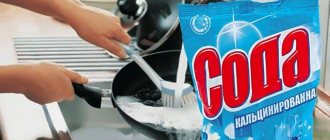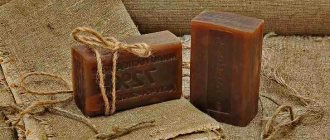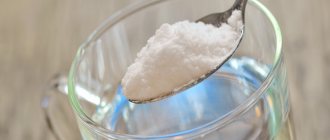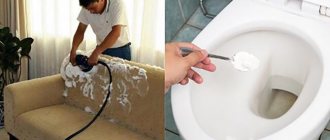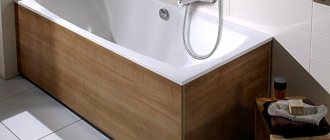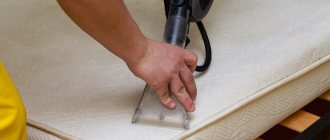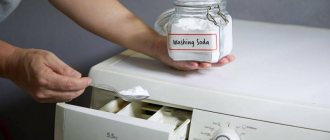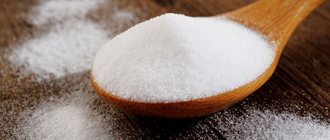Soda ash is used in many industries: in industry (petroleum, soap, glass, textile, etc.), in agriculture (for disinfecting livestock premises and treating plants against pests), as well as in everyday life.
Nowadays, laundry soda in its pure form is not often found in housewives’ arsenal, although until recently it was the main remedy for any contamination. Today it is usually used as part of multi-component cleaners.
Types of substances
All types of product are sodium. But their properties are different, which determines the methods of their use.
There are several types of this substance:
- Food. Used for baking. It is a fine-crystalline powder, white, odorless. Formula - NAHCO3. It is also called bicarbonate, bicarbonate, sodium bicarbonate.
- Calcined (Na2CO3). The material is white with a slightly grayish tint, finely crystalline. It has been given several names: sodium carbonate, linen, sodium salt of carbonic acid. For production, dehydration (calcination) technology is used.
- Caustic or sodium hydroxide (NaOH). Also called caustic soda, for its ability to quickly corrode the skin. It is white in color, has a solid crystal structure, and is odorless. It has increased hygroscopicity and is able to absorb moisture from the air. When dissolved, it undergoes a violent reaction with the release of heat, the water becomes soapy.
Use in everyday life
Using soda is easy, and the results appear quickly, so alkali is used whenever you need to break through a blockage in sewer pipes, remove difficult stains, or wash kitchen utensils or the oven. Caustic soda is used in many cases and helps keep the house clean, protect the garden from pests, and clean sewer pipes.
In agriculture
- Trees are treated with the solution to get rid of pests: powdery mildew, cabbage caterpillars, aphids, viburnum leaf beetle (5 tsp/10 l of water).
- Gardeners use alkali to kill weeds.
- After disinfection of tools, the spread of plant diseases stops.
- When prophylactically spraying grapes, the berries turn out to be sweeter, and the plant does not suffer from gray rot.
- Treatment with a solution of 80 g of caustic in 10 liters of water prevents yellowing of leaves on berry bushes and cucumbers.
- Greenhouses are disinfected with a caustic solution (5 tsp/10 l of water) after harvesting.
Removing scale and deposits from dishes
It’s not at all difficult to wash off several layers of grease from the oven and grate on a gas stove, wash the tiles so that they shine like new, and give new life to old frying pans and saucepans. Since all these contaminants are of organic origin, caustic soda is the simplest solution to the problem.
Important! Do not use caustic to clean aluminum and Teflon cookware - the substance destroys these materials.
Rub a piece of laundry soap, mix it with 200 g of caustic soda and silicate glue (150 g). Dissolve the mixture in 10 liters of water in a metal, preferably enameled, container. Immerse the dish and keep on low heat for about 2 hours. After treatment, cleaned utensils should be rinsed well under running water. For glassware, 10 minutes of boiling is sufficient.
Caustic soda for dishes
Making homemade soaps and detergents
Homemade soap making has become a craze; a useful hobby allows you to show your creativity and prepare soap based on your personal needs. Toilet soap consists of NaOH, water, vegetable and essential oils. You can add more fat if you have dry skin, give the soap any scent and color - as you experiment, you will find your own recipe. Soap production technology consists of several stages:
- Combine caustic soda with water.
- Add fat (vegetable oil).
- Add a few drops of essential oil or a mixture of several scents.
To avoid burns, handle lye carefully and keep vinegar on hand in case the baking soda gets on your skin. Dry the bar of soap for several weeks before use, then the caustic soda will lose its properties that are dangerous to the skin.
Soap making has become an exciting hobby for many.
Important! The more fat you add to the soap, the more completely the soda will react (extinguish), and the less likely it is that you will dry out your skin.
Caustic soda for homemade soap must be purified. You can buy raw materials in specialized stores for soap makers.
Caustic soda is used to wash clothes; it can even remove traces of fuel oil, and ordinary greasy stains are removed with a 99.9% guarantee. Dissolve NaOH in water at the rate of 1 tablespoon of alkali per liter of water. Soak for a couple of hours and rinse in plenty of hot water. Bed linen can also be bleached in an aqueous solution of caustic soda, but the exposure time is reduced to 1-1.5 hours.
Attention! The method is not suitable for natural fabrics - caustic dissolves organic matter, so wool and silk can disintegrate into fibers.
Washing gel:
- Water - 3 l.
- Laundry soap shavings - 15 g.
- Caustic - 150 g.
- Pharmacy antiseptic sodium tetraborate – 150 g.
A product similar to CALGON for a washing machine:
- Add 40 g NaOH to the machine tank.
Caustic soda cleans floors well. Dilute 3-4 tablespoons of powder in 5 liters of water, wipe the floor with the solution and rinse with clean water.
Removing blockages
Caustic soda and vinegar are the most affordable means of removing blockages in sewer pipes. Sodium hydroxide actively breaks down organic deposits, hair and animal fur, and other debris that clogs pipes. The action continues even after the dirt plug is eliminated, and roughness and deposits on the inner surface of the pipes are simultaneously cleaned.
Advice. Soda can be used preventively, since serious blockages do not form in one day. Clean the pipes with a weak caustic solution once a month to avoid accidents.
If a blockage has already formed, alkali in any form will help clear the pipes, but powder is most effective. You will need: rubber gloves, a plastic bucket, a dustpan, safety glasses and a respirator mask.
Caustic soda for clearing blockages
- Wear rubber gloves and goggles.
- Scoop 2 to 5 kg of caustic soda into a bucket, add water and stir. The reaction will be accompanied by heating to 60°C - the bucket must be durable and the actions must be careful.
- Once completely dissolved, pour the solution down the drain. As a rule, 4-5 liters and 2-3 hours are enough to eliminate serious blockages in an apartment building.
- Rinse the drain with boiling water and use a plunger.
Advice. Do not prepare more solution than you intend to use, as it can only be stored for one week in a sturdy enamel canister. Plastic containers for storing alkali are not suitable.
Caustic acid corrodes the enamel of sinks and bathtubs - try to minimize contact of the solution with these surfaces. If the drain is clogged with soil, the effect of the application will be small.
Cesspool cleaning
Silting of a cesspool is a problem familiar to summer residents and homeowners. There are simple, sealed and septic cesspools, and they all require cleaning sooner or later. Caustic soda is a simple, effective and cheap way:
- Pour 3 kg of caustic soda into 7 liters of cold water. Stir.
- Pour into the drain and do not use the sewer for 2-3 hours.
- Pour 5-20 liters of boiling water.
When working with caustic soda, you need to wear rubber gloves, a respirator mask and safety glasses.
Application and difference of forms
Soda ash and caustic soda have found their application in solving the household needs of the population. They are used as cleaning and detergents.
In addition, they are freely used in various industrial sectors, in the production of goods of various consumption.
Sodium carbonic acid is made from caustic! This is one of the ways (it is also obtained from natural raw materials, nephelines, sodium chloride).
Carbonation is the result of various chemical processes occurring under the influence of high temperatures. From what sodium hydroxide turns into sodium carbonate.
After undergoing heat treatment, caustic soda and its derivative, calcined, acquire distinctive characteristics.
Recommended for you:
Using caustic soda to flush various cooling and heating systems
The main differences lie in different properties, areas of application, and crystal structure.
Sodium carbonate is available in the form of a homogeneous powder or small granules. It is the basis for the manufacture of cleaning products, washing dishes, various surfaces, and containers. Detergents based on Na2CO3 easily dissolve fats, oils, and lime deposits.
Expert opinion
Advice!
Soda ash is an excellent bioregulator for alkalizing an acidic environment. With its help, you can soften water and prevent the formation of lime deposits in washing machines and water heating tanks.
In addition, sodium carbonate is used in glass production. It is an essential component during the glass production operation.
Also indispensable in the manufacture of paper, cardboard, other cellulose products, and the production of petroleum products
Advantages and disadvantages
Pros of caustic soda:
- eliminates stubborn stains faster and more effectively than regular soda or other folk remedies;
- Suitable for preventive cleaning of sewers and removing blockages;
- removes stubborn stains on clothes;
- can be used as an antiseptic, to treat premises;
- inexpensive.
Minuses:
- caustic is dangerous: if it gets on the skin or mucous membranes, there will be severe burns;
- the caustic composition can damage galvanized, aluminum or enamel coatings, as well as delicate fabrics when washed;
- after the expiration date and improper storage, for example, in a damp room, it loses its properties.
Obtaining the substance
There are about sixty natural deposits on the planet for the extraction of material for the production of Na2CO3.
These are, as a rule, soda lakes, located mostly on the American continent. They are also found in the territories beyond Lake Baikal and the western regions of Siberia.
In addition, the ashes of burnt algae and plants growing on the shores of reservoirs are used to obtain the product.
Today, four methods are used to obtain Na2CO3:
- Ammoniacal (from sodium chloride). The method is costly and environmentally unsafe.
- Using natural soda raw materials. Salt water and sediments (brine) from estuaries, lakes, and artificial reservoirs are processed.
- Using ore containing nepheline. When processing raw materials, Na2CO3 and potash are obtained.
- Carbonation of sodium hydroxide. That is, the production of soda ash from caustic soda.
Of all the above methods, the cheapest and most environmentally friendly is the use of natural soda raw materials.
Using soda ash
Na2CO3 is successfully used for a variety of household purposes. Sodium carbonate, when added to water, will reduce hardness.
Washing powders and other detergents are made with the addition of this substance. Housewives successfully use it when washing dishes.
But you must take precautions and protect the skin of your hands with rubber gloves.
- The dishwashing solution is prepared as follows: take 3 tbsp. l. soda ash, dissolve in 3 liters of hot water.
Recommended for you:
American baking soda: how it differs from regular soda, beneficial properties, methods of use
This solution is enough to wash a significant amount of dirty dishes. Afterwards, clean plates must be rinsed in warm water.
There is no point in using additional detergents, since the Na2CO3 solution solves the problem 100%. It not only degreases, but also helps get rid of negative microorganisms.
A real scourge for household appliances intended for washing and heating water is the presence of lime deposits.
To prevent scale, use a mixture of sodium carbonic acid at least twice a month.
- You need to do this as follows: pour 5 tbsp into the laundry chamber or inside the water heating container. l. baking soda.
- Switch the washing machine to washing mode, heat the tank to 90 °C, and let the unit run for a while. After completing the process, rinse the equipment with a strong stream of water.
Na2CO3 can be used for washing dirty clothes, oily overalls or clothes.
- The solution is prepared as follows: add 1 to 3 tbsp to the receiving chamber of the washing machine, and in the case of hand washing, add 1 to 3 tbsp to a bowl of water. l. soda
The dose should be adjusted based on the degree of soiling of the clothing, the persistence of the stains, and their number. In this situation, it is necessary to strengthen the washing powder with sodium carbonate.
But it must be used in doses, as it makes the water soft, which increases the volume of soap suds.
The listed methods of application are the most common and most used. Although the potential of the substance is very great, it can have a wider range of circulation.
Two such similar but different sodas: what is the difference, and how to use them?
Almost every home has a pack of regular soda.
But here lies one catch - although in Russia we have only one name for soda, in fact there are two varieties of them - washing soda (sodium carbonate, Na 2 C O 3 ) and baking soda (sodium bicarbonate, NaHCO 3 ).
Although they have a common name, their uses are very different from each other in many ways. Washing soda is recognized by the average person primarily in the form of a powder for washing stains and grease, or as a component of a clothes softener when washing. It is much more caustic than baking soda and is quite low on the acidity scale, meaning it is more alkaline. Its main use, in addition to the above-mentioned household use, is the production of glass (it facilitates melting) and the regulation of acidity in liquids (for example, in swimming pools after adding chlorine, which greatly makes the water in the pool more acidic).
Even in everyday life, this soda can be used to remove blood, alcohol, coffee or grease stains from clothes, as well as to disinfect surfaces (floor, bathroom, etc.) if mixed with water. However, under no circumstances should you eat it - if consumed in its pure form, it is poison!
It can also cause burns if it comes into direct contact with the skin, so you need to be especially careful when handling it and use gloves.
Baking soda is another matter. It can be eaten in small quantities with a pure heart. Usually, however, in the form of a solution in water - this can serve as a mild remedy for heartburn, or as an ingredient in baked goods - here baking soda serves as a leavening agent. Coming into contact with the dough, especially actively under the influence of acetic acid, baking soda releases bubbles of carbon dioxide, thereby raising the dough and giving it fluffiness. But moderation is important everywhere! Too much baking soda can cause an unpleasant taste, so you need to strictly follow traditional recipes and maintain proper proportions.
In addition, baking soda has a calming effect. It can be applied to the skin as a paste (in a viscous mixture with water) after insect bites or after sunburn. And in general, baking soda, unlike its relative, is friendly to the human body and is even produced by it naturally. This fact contributes to the widespread use of baking soda solution in medicine - to balance the acidity of the patient’s blood.
However, the two types of soda have something similar. Although less caustic, baking soda can also perform some of the functions of baking soda, removing stains and balancing acidity.
Often, as a result of various chemical reactions, it happens that one soda gives rise to another. Therefore, it cannot be said that these are two completely separate substances - they are interconnected and largely share their properties.
Both sodas - baking soda and household soda - play an important role in the life of a modern person and will continue to remain a mandatory household attribute in every home!
Share on social networks:
Application of caustic soda
This substance is produced in two versions: in the form of small white flakes, very hygroscopic, quickly dissolving, and in the form of a colorless concentrated liquid.
NaOH is used in:
- industrial production for neutralizing various acids;
- pharmaceuticals in the manufacture of the disinfectant chloramine;
- home conditions for cleaning sewer systems.
Recommended for you:
What is bread soda, benefits and harm, how to use
To clean the drains, you need 5 or 7 tbsp. l. Pour caustic soda into the sewer pipe and pour hot water on top.
For about 2-3 hours, it is advisable to refrain from using the sewer and do not drain the water. A similar sequence can be carried out both when cleaning contaminated pipes and as preventive measures.
Use in production
This substance has proven to be very useful in many industries and plays a fairly important role in many situations. You might even be surprised how many things contain caustic soda, and the people who use these things in their lives have no idea. For example, in the chemical industry, this substance is used in a variety of detergents and in a huge number of complex reactions, helping to create other substances. In the food industry, caustic soda is often used to clean machines and other equipment in production, and it is also one of the food additives.
Because of its cleaning properties, soda is also used in the light industry - it allows you to easily bleach fabrics. It can also be used in biofuels and for the manufacture of alkaline batteries. So the options for its application in industry are simply enormous. But at the same time, it can be used in everyday life, and not just in large factories.
Reviews
Stepan Vladimirovich, 54 years old
Sodium carbonate is simply irreplaceable in the household. For example, my wife always washes my work clothes (I work in a carriage building shop) with this substance. It removes stains from industrial oils with a bang. Recently I had to clean such dirt on a car seat. It turned out great.
Maxim Sergeevich, 36 years old
It was necessary to clean the old radiator from the stove. They suggested caustic soda for this purpose. Cleaned it well, removed dirt and oil quickly. In principle, that’s what was required.
Tamara Sergeevna, 48 years old
I have been using soda ash almost all my life. My mother also used it. A very good product for cleaning tiles, dishes, stoves, and sinks. Better than all these newfangled products.
More information about the product
Where to buy caustic soda
Caustic soda is a consumer product. You can buy it from TD “Mechanika” in any quantity.
Working with caustic soda at home is not very convenient, especially if there are small children and animals. Despite this, the tradition of using it in everyday life remains, which can be explained by the effectiveness and low cost of the product. When using alkali, be careful, then caustic will become your reliable assistant in maintaining cleanliness.
When working with caustic soda, take precautions - rubber gloves are required.
Safety regulations
Alkali has properties that require caution. When working with a caustic substance, follow the rules to avoid caustic soda poisoning and burns:
- Wear rubber gloves, glasses, and clothing that covers your skin.
- Before starting work, check that the caustic will not come into contact with metals. Such a “meeting” can provoke an aggressive reaction.
- Follow the recommended proportions of water and caustic soda; this is especially important when cleaning enamel dishes and soaking fabrics.
- Wash your hands well after handling the substance.
- Try to work with caustic soda in a room with open windows, close the container with soda - the maximum permissible concentration in the air is 0.5 mg/m³.
- Caustic soda should be stored in closed containers and in a place guaranteed to be protected from children and pets.
- GOST 2263 regulates the transportation, storage and packaging, and shelf life of caustic soda. Liquid or granular sodium hydroxide must be in a container that does not react with the substance and provides an airtight seal. The substance should be stored at home in its original packaging.
What to do in case of a caustic burn
NaOH burns are dangerous and occur frequently. When concentrated alkali gets into exposed areas of the body, the substance penetrates deep into the skin and can cause tissue necrosis. Contact with eyes may result in loss of vision.
First aid for burns of the mucous membrane or skin with caustic is immediate rinsing with plenty of running water and treating the affected area with boric acid. If alkali gets into your eyes, you must immediately rinse them under running cold water and consult a doctor as soon as possible.


